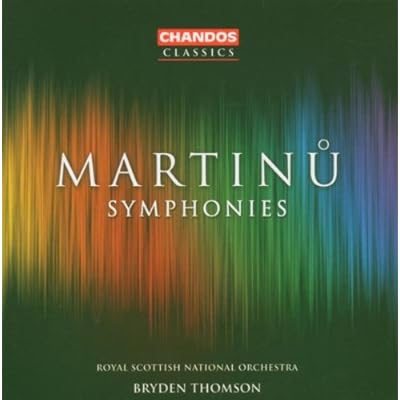
Bryden Thomson / Scottish National Orchestra
Bohuslav Martinů was a Bohemian Czech composer of neo-classical and neo-Romantic music. He wrote 6 symphonies in all, and here they are in their entirety. His music is extremely accessible and lovely - reminiscent of Hindemith, Copland, and even Bartók at times... I absolutely love the first symphony, but all of them are so admirably perfect and SO underrated.
Bohuslav Martinů (1890-1959) only began composing symphonies after fleeing the Nazis into American exile in 1941. He was of a generation that saw the symphony as passé -- Bartók was born in 1881 and Stravinsky in 1882, and Martinů was born in 1890 -- while Mahler was born in 1860, and Sibelius and Nielsen in 1865. Modernism entailed new forms and styles, and while Martinu was never a modernist he did inhabit a soundworld with a lighter touch full of dance rhythms, not heavy, four-square symphonies. But he received a commission from Koussevitsky and the Boston Symphony, so he wrote a symphony. And then another, and another... He ended up composing a symphony a year every year from 1942 to 1946, No.s 1 through 5, and later a Sixth, his most popular. They are graceful, full of dancing rhythms, and of classical proportions, ranging from 23 to 36 minutes in length. Symphonies 1, 2 and 4 are in the traditional four-movement form, while No.s 3, 5 and 6 each have three movements. The First, Third and Sixth were premiered by the Boston Symphony, the Second was premiered by the Cleveland Orchestra, the Fourth was premiered by the Philadelphia Orchestra, and the Fifth is unique in having been premiered by the Czech Philharmonic and Rafael Kubelik.
Symphony No. 1 demonstrated that Martinů's gifts, previously applied to the concerto grosso form, all manner of chamber music, and opera, could be applied to great effect to the symphonic form, despite his misgivings. Its success spurred him on. Symphony No. 2 is shorter and uses Czech and Moravian folk melodies in the slow movement, his most Czech symphony, and features the use of several small groups of instruments. Symphony No. 3 stands out from the others in its dark and somber hue. While parts of the First and Second had reflected the war, the Third is clearly marked by it through and through. It is Martinů's only work that reminds me of Shostakovich in its gravity and tragic cast. It is a powerful work which ends without a triumphant resolution, despite Beethoven's Eroica being an inspiration and despite the D-Day landing at Normandy taking place shortly before Martinů completed it. Though atypical, I consider this to be one of the finest jewels in this string of six. The Fourth complements the Third perfectly as it celebrates victory. The second movement Allegro vivo reminds me of nothing so much as the scherzo to Beethoven's 9th, a propulsive dancing march rhythm. It has the forward momentum of the opening of Roussel's Third Symphony, but is lighter on its feet. And the Poco allegro finale is an ecstatic celebration, the triumph that was withheld at the conclusion of the Third. The Fifth is more questing and tentative after that burst of enthusiasm. It was first heard at the inaugural Prague Spring Festival in 1947. A head injury caused by a fall from an open second-floor terrace led to several years of expensive treatment and convalesence, but Martinů returned to composing at the peak of his powers. The Sixth was finished in 1953, and is the most broadly Romantic of his symphonies, sounding like Copland in parts with lush, sweeping melodies, and using the melody "Across the Wide Missouri," though I've never seen this mentioned anywhere. Listen for yourself and see. It remains one of Martinů's most popular works.





0 comments:
Post a Comment